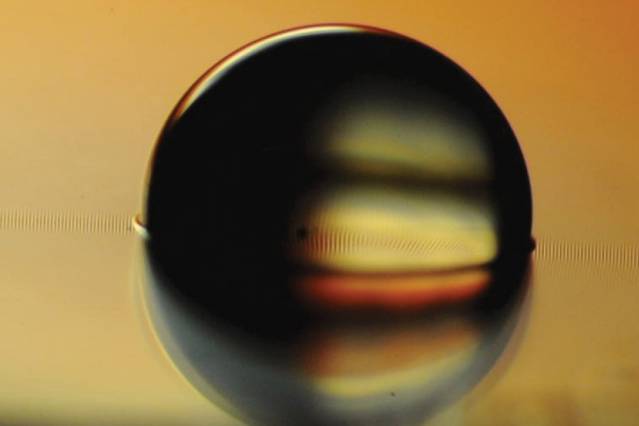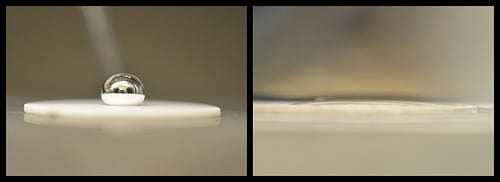
Image courtesy of the researchers
Researchers develop treated surfaces that can actively control how fluids or particles move.
Researchers at MIT and in Saudi Arabia have developed a new way of making surfaces that can actively control how fluids or particles move across them. The work might enable new kinds of biomedical or microfluidic devices, or solar panels that could automatically clean themselves of dust and grit.
“Most surfaces are passive,” says Kripa Varanasi, an associate professor of mechanical engineering at MIT, and senior author of a paper describing the new system in the journalApplied Physics Letters. “They rely on gravity, or other forces, to move fluids or particles.”
Watch a water droplet get pulled across an “active” surface designed by MIT researchers.
Video: Melanie Gonick/MIT
Varanasi’s team decided to use external fields, such as magnetic fields, to make surfaces active, exerting precise control over the behavior of particles or droplets moving over them.
The system makes use of a microtextured surface, with bumps or ridges just a few micrometers across, that is then impregnated with a fluid that can be manipulated — for example, an oil infused with tiny magnetic particles, or ferrofluid, which can be pushed and pulled by applying a magnetic field to the surface. When droplets of water or tiny particles are placed on the surface, a thin coating of the fluid covers them, forming a magnetic cloak.
The thin magnetized cloak can then actually pull the droplet or particle along as the layer itself is drawn magnetically across the surface. Tiny ferromagnetic particles, approximately 10 nanometers in diameter, in the ferrofluid could allow precision control when it’s needed — such as in a microfluidic device used to test biological or chemical samples by mixing them with a variety of reagents. Unlike the fixed channels of conventional microfluidics, such surfaces could have “virtual” channels that could be reconfigured at will.
While other researchers have developed systems that use magnetism to move particles or fluids, these require the material being moved to be magnetic, and very strong magnetic fields to move them around. The new system, which produces a superslippery surface that lets fluids and particles slide around with virtually no friction, needs much less force to move these materials. “This allows us to attain high velocities with small applied forces,” says MIT graduate student Karim Khalil, the paper’s lead author.
The new approach, he says, could be useful for a range of applications: For example, solar panels and the mirrors used in solar-concentrating systems can quickly lose a significant percentage of their efficiency when dust, moisture, or other materials accumulate on their surfaces. But if coated with such an active surface material, a brief magnetic pulse could be used to sweep the material away.
Read more . . .
The Latest on: Droplet-based microfluidic platforms
[google_news title=”” keyword=”Droplet-based microfluidic platforms” num_posts=”10″ blurb_length=”0″ show_thumb=”left”]
via Google News
The Latest on: Droplet-based microfluidic platforms
- Nanoparticle researchers develop microfluidic platform for better delivery of gene therapy for lung diseaseon May 7, 2024 at 7:14 am
Drug delivery researchers at Oregon State University have developed a device with the potential to improve gene therapy for patients with inherited lung diseases such as cystic fibrosis.
- Rich molecular language guides tiny liquid droplet formation in cellson May 6, 2024 at 10:33 pm
Peering into a biological cell reveals a bustling microscopic world. The workhorses within this realm are specialized structures called organelles that perform vital cellular functions. Curiously, ...
- INEO Partners with US-Based Ad Platformson April 8, 2024 at 11:59 pm
(the "Company" or "INEO"), announces the signing of new strategic partnerships with several prominent US-based advertising platforms and the setting up of Private Marketplace (PMP) deals with ...
- C-CAMP develops new affordable platform to study single cellson April 2, 2024 at 2:02 pm
“Traditional flow cytometers, used for fluorophore-based ... platform using a proprietary microfluidic chip with integrated optical fibres, photomultiplier tubes, and a pulse counter. As each ...
- Droplet Microfluidics in PCR: Technology and Applicationson March 26, 2024 at 4:00 am
Digital Droplet PCR (ddPCR) is a method for performing digital PCR use microfluidic water-oil emulsion technology. By utilizing microfluidics and fractionating DNA samples into nanoliter droplets , ...
- Mastering the flow in tiny spaces – an overview of microfluidicson February 19, 2023 at 8:44 am
In a similar manner, 3D printers utilize a microfluidic nozzle to release molten polymer or other liquid materials. Concept of the integration of an inkjet dispenser and a microfluidic mixer enabling ...
- Droplet generation in microfluidicson August 30, 2022 at 8:18 am
Droplet-based microfluidic systems have already entered laboratories, and currently, it is possible to create (monodisperse) droplets that range in size from femto to nanoliters. Therefore ...
- Dolomite Microfluidics – Droplet Systemon October 31, 2017 at 9:40 am
All systems include a range of Droplet Junction Chips with different junction geometries, channel sizes and surface properties; enabling users to generate droplets in any size and scale they want.
- Microfluidic LEGO Brickson February 28, 2017 at 5:34 am
Years ago, prototyping microfluidic systems was a long, time-intensive task. With inspiration from DIY PCB fabrication techniques, that time is now greatly reduced. However, even with the ...
via Bing News









